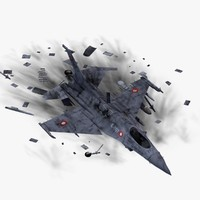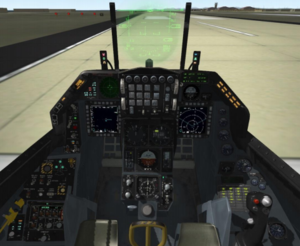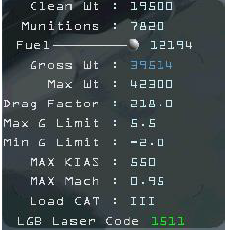Emergency procedures
In BMS there are no random failures of your jet. This is a good thing. The bad thing is there is a complex system of inter-related faults and problems that can arise when you either A: get shot, or B: do something stupid.
Contents
Learning objectives
- Learn how to recognize faults
- Know how to avoid faults
- Recover from stalls
- Use an emergency checklist
Learning files
- BMS 4.33 Dash 1 SECTION III (p168)
- BMS-Training.pdf mission 7 (p62) and mission 9 (p78)
- F-16 Loss of Control, Test Pilot on Yaw Departure
Emergency situations
The most common problems caused by battle damage will be loss of one or more navigation systems, or damage that reduces the capability of your engine. You should familiarise yourself with the various backup systems available, not only in the jet but on the ground in terms of TACAN frequencies, alternative landing fields etc.
There are 3 basic rules to be followed in any in-flight emergency:
- Maintain aircraft control
- Find out what is wrong
- Land as soon as the situation dictates
This can happen on ingress to a mission and mean you will need to abort. This is a tough call but there’s no point in nursing a half dead aircraft into a situation where you can’t effectively defend yourself or your partner. You should RTB as soon as possible. You should not RTB alone, your wingman will accompany you and keep an eye on you.
Systems
The warning/caution system is made of different subsystems:
- Warning lights (amber lights on the eyebrows)
- MASTER CAUTION (press to reset amber light on the left eyebrow)
- Caution lights (yellow lights on the right auxiliary console caution panel)
- PFLD (Pilot Fault List Display - small screen on the right auxiliary console accessed with the F-ACK button on the left eyebrow)
- Maintenance Fault List
- VMS (Voice Message System – aka Bitching Betty)
- HUD messages
The Master caution light will come on to alert you to a condition. It means: look at your caution panel now. Do not just press the Master caution light, it will not clear the fault.
The subject of Emergency procedures is huge and the pilot should work through the material provided with the sim to gain a proper understanding. I will attempt to cover the most common problems you will encounter and explain how they can be dealt with.
To do
- Exceeding g-limits or airspeed for stores
- Engine damage
- Engine failure in flight
- FLCS failure
- Radio failure
- Nav failure
- HUD failure
- Gear failure
Exceeding g-limits or airspeed for stores
The things you hang off your jet will have an effect on it’s performance. You will not be able to achieve full speed and the G’s you can pull will be limited. A light load of Air to Air weapons will not have much effect, but an aircraft loaded to the max with bombs will be noticeably limited.
Before the mission you should refer to the bottom right of your loadout screen
and note the Max and Min G limit and the Max and Min IAS (indicated airspeed) and Mach.
If you exceed these limits it’s likely that you will break something your bomb fuzes may fail, or your pylon stations may pack in and you will not be able to use your ordnance. In the sim you will hear ominous groaning sounds if you go too fast or pull too many g’s. Note that the negative G number in particular is very small. Be especially careful when flying NOE or “bunting” the nose down as it doesn't take much to break something.
Actions on hearing the dreaded graunching sound or on suspected over-g/speed:
Look at the PFLD. Any stations that are damaged will be listed there. There are 9 available stations, the display will say either SMS STAx DEGR or SMS STAx FAIL. You must cross reference with your SMS page on the MFD and work out what’s hanging on the damaged station. If it’s your bombs, then there’s a good chance they won’t come off or won’t go bang.
You could consider flying as escort for the rest of your package or RTB. If it’s your A/A stores you need to think about your survivability in an engagement. Either way, inform your flight lead immediately so they can come up with a plan.{{#invoke:Navbox|navbox}}


